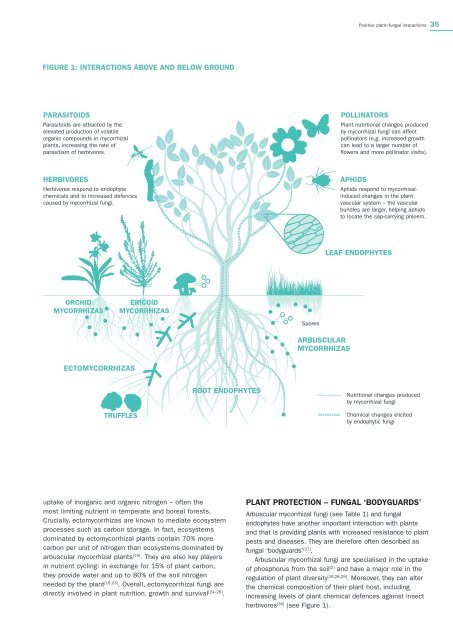gom1
You also want an ePaper? Increase the reach of your titles
YUMPU automatically turns print PDFs into web optimized ePapers that Google loves.
Positive plant–fungal interactions 35<br />
FIGURE 1: INTERACTIONS ABOVE AND BELOW GROUND<br />
PARASITOIDS<br />
Parasitoids are attracted by the<br />
elevated production of volatile<br />
organic compounds in mycorrhizal<br />
plants, increasing the rate of<br />
parasitism of herbivores.<br />
POLLINATORS<br />
Plant nutritional changes produced<br />
by mycorrhizal fungi can affect<br />
pollinators (e.g. increased growth<br />
can lead to a larger number of<br />
flowers and more pollinator visits).<br />
HERBIVORES<br />
Herbivores respond to endophyte<br />
chemicals and to increased defences<br />
caused by mycorrhizal fungi.<br />
APHIDS<br />
Aphids respond to mycorrhizalinduced<br />
changes in the plant<br />
vascular system – the vascular<br />
bundles are larger, helping aphids<br />
to locate the sap-carrying phloem.<br />
LEAF ENDOPHYTES<br />
ORCHID<br />
MYCORRHIZAS<br />
ERICOID<br />
MYCORRHIZAS<br />
Spores<br />
ARBUSCULAR<br />
MYCORRHIZAS<br />
ECTOMYCORRHIZAS<br />
ROOT ENDOPHYTES<br />
Nutritional changes produced<br />
by mycorrhizal fungi<br />
TRUFFLES<br />
xxxxxxxxxx<br />
Chemical changes elicited<br />
by endophytic fungi<br />
uptake of inorganic and organic nitrogen – often the<br />
most limiting nutrient in temperate and boreal forests.<br />
Crucially, ectomycorrhizas are known to mediate ecosystem<br />
processes such as carbon storage. In fact, ecosystems<br />
dominated by ectomycorrhizal plants contain 70% more<br />
carbon per unit of nitrogen than ecosystems dominated by<br />
arbuscular mycorrhizal plants [19] . They are also key players<br />
in nutrient cycling: in exchange for 15% of plant carbon,<br />
they provide water and up to 80% of the soil nitrogen<br />
needed by the plant [16,23] . Overall, ectomycorrhizal fungi are<br />
directly involved in plant nutrition, growth and survival [24–26] .<br />
PLANT PROTECTION – FUNGAL ‘BODYGUARDS’<br />
Arbuscular mycorrhizal fungi (see Table 1) and fungal<br />
endophytes have another important interaction with plants<br />
and that is providing plants with increased resistance to plant<br />
pests and diseases. They are therefore often described as<br />
fungal ‘bodyguards’ [27] .<br />
Arbuscular mycorrhizal fungi are specialised in the uptake<br />
of phosphorus from the soil [2] and have a major role in the<br />
regulation of plant diversity [16,28,29] . Moreover, they can alter<br />
the chemical composition of their plant host, including<br />
increasing levels of plant chemical defences against insect<br />
herbivores [30] (see Figure 1).

















